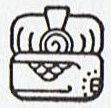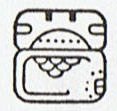6. In the Moko chapter - which should be reread in extenso at this point - the moko sign (in hanau moko) was found in line b3 (the line with no signs of henua):
One of the sons of the great Tu, according to the myth of creation of Chatham Islands, was named Moko: ... Let the spirit of the man be gathered to the world of being, the world of light. / Then see. Placed in the body is the flying bird, the spirit-breath. / Then breathe! / Sneeze, living spirit, to the world of being, the world of light. / Then see. Placed in the body is the flying bird, the breath. / Be breathing then, great Tu. Now live!
At Eb7-8 Metoro said ko raua ka tutu and at Eb7-9 he said ka tupu te rakau. Notice his choice of words with what presumably was meant to indicate an end (ka tutu) followed by a new beginning (ka tupu), a reversal accomplished by the same vowels but with different consonants. The wordplay also involves ko ra-ua changing into te ra-kau, where ko is something else than te (cfr its use in Makoi's List of Place Names), and where ua changes into au (the meaning of which possibly extends further on into other Polynesian subtleties beyond our present knowledge). Maybe Metoro meant that Sun (Raa) was drenched by rain (ûa) - or rather perhaps by a high tide (u'a) - and washed down (tutu should be the opposite of tuu, to stand erect). One is reminded of Inky Pinky Spider who was climbing up the spout, but then came the rain and washed poor spider out. But Sun shone anew and dried away all rain, and Inky Pinky Spider was climbing up again. In that perspective the growing tree (ka tupu te rakau) possibly should be understood as how in the evening, after sundown, people down on earth created new fires of their own, and these stretched their flames high into the sky like fiery growing trees.
In my outline of a glyph type dictionary I have described the divisions of the day according to the Hawaiians: ... Considering why there always are 3 vertical 'beams' in hau tea - it must have a meaning - and based on the assumption that it is sun beams which are illustrated, the natural conclusion will be that the three 'beams' indicate the division of the day: 'The Hawaiian day was divided in three general parts, like that of the early Greeks and Latins, - morning, noon, and afternoon - Kakahi-aka, breaking the shadows, scil. of night; Awakea, for Ao-akea, the plain full day; and Auina-la, the decline of the day. The lapse of the night, however, was noted by five stations, if I may say so, and four intervals of time, viz.: (1.) Kihi, at 6 P.M., or about sunset; (2.) Pili, between sunset and midnight; (3) Kau, indicating midnight; (4.) Pilipuka, between midnight and surise, or about 3 A.M.; (5.) Kihipuka, corresponding to sunrise, or about 6 A.M. ...' (Fornander) Time consisted of night + day = 4 + 3 = 7. The Polynesians considered the origin was in the darkest of night, with light arriving only later:
Fornander is not clear as to how the night was structured in Hawaii, but 4 intervals of time there were. I have put midnight in a special (black) box because it marks the 'death' of the old day (and the birth of a new day). The division ('cut') of time at midnight makes it natural to have a balance with 2 intervals before and 2 intervals after. There is no similar 'cut' at noon. Time begins anew (with a new cycle) at the darkest place. Pilipuka is the first 'season' of the day and Pili the 7th ... |

















